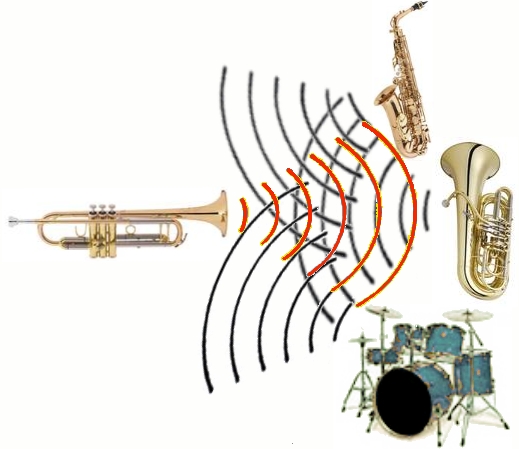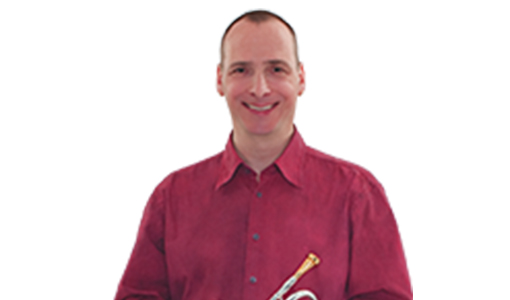Acoustic facts
Wer ein Blechblasinstrument spielt, sollte auch über akustische Zusammenhänge informiert sein, die einem das ohnehin schon oft anstrengende Leben als Blechbläser verständlicher machen, erleichtern können oder gelegentlich auch die Frage ersparen können: Warum etwas "heute" nicht so gut klappt wie "gestern", ohne das es an der Form des Blechbläsers liegt.
Ich kann mich noch an alte Filme erinnern, die zu Zeiten gedreht wurden als unsere Hörgeräteakustik noch nicht so weit fortgeschritten war, um Schwerhörige mit den heute verwendeten elektronischen Hörgeräten zu versorgen. Darum verwendete man "Hörrohre".
Diese waren in gewisser Weise ähnlich wie Blechblasinstrumente: Ein Rohr mit einem Trichter dran. Es ist klar, ein Trichter, wie bei den Blechblasinstrumenten ist nicht nur sehr gut geeignet um Schallwellen abzugeben, sondern wie bei den alten Hörgeräten, "Hörrohren", auch gut geeignet um Schallwellen aufzufangen.
Acoustic problems
This leads us to the first problem brass players are facing: a brass instrument’s funnel not only emits sound waves"”it also receives them. This causes a second problem: the funnel not only captures sound waves it emitted in the first place, but also from other sound sources close to it.
Its own sound waves are not necessarily a problem and may indeed have a positive effect, because they amplify the brass instrument’s sound source: our lips. This may appear a little abstract, so I suggest we analyze several situations to discover what exactly happens.
While a brass player is alone in a room, the following may occur:
the brass player starts blowing into his horn, the lips (sound source) start vibrating and to generate a note (sound waves). These sound waves vibrate inside the instrument, and some of them are dispersed in the room.
The room’s surfaces now determine how many of those sound waves are swallowed (absorbed) and how many are reflected. By "surfaces" I mean the floor (carpet, tiles or parquet), curtains and other objects likely to absorb sound waves.
Sound absorption
Flat surfaces reflect sound, while textured surfaces absorb it. Depending on the surface structure, some frequencies are absorbed more than others. That is what we mean when we say a room has a "bright" (low frequencies are absorbed) or a "dark" sound (high frequencies are absorbed). Let us not go into too much detail here, because this is not really the point I want to make. Back to brass instruments.
If most sound waves are absorbed (complete absorption is impossible), they are not reflected, and so do not return into the funnel where they could merge with the standing wave inside the instrument and hence influence the sound wave. Consequently, the sound wave (lips) is neither altered, nor supported by reflected sound waves. This gives the player the impression that they need to "work harder", which typically occurs in a recording studio.
This may cause a feeling of fatigue, because you feel you need to blow harder. A similar feeling occurs when you play outside, because there are far fewer reflections. The opposite happens when you play in a venue with strong reverberation: as a lot of sound waves are reflected by the room (walls and floor), they return to the instrument’s funnel where they meet the instrument’s standing wave. The latter is amplified, returns to the vibration source (your lips) and supports the vibrations there. This creates the impression that playing becomes easier, that higher notes are easier to play and that one doesn’t have to "work" so hard.

Additional sound sources
Let us now look at the next case: brass players are hardly ever on their own"”they usually play with other musicians. The waves of such additional sound sources also enter a brass instrument’s funnel and are transmitted to the player’s lips. The effect of such reflections differs: if the other sound sources are also brass players, good intonation on their part may be helpful for you, while flat or sharp notes may make it more difficult for you to hit the right pitch. This obviously applies to all instrument playing simultaneously. Sound sources with distortion or effects, like guitars or synthesizers can be a real pain in this respect. Drums, too, can cause interference.
Obviously, one necessarily has to play together with all other instruments, which means that there will always be sound waves to "fight". But now you know why playing can sometimes feel more difficult. And this may help you come to grips with your own weaknesses: practicing in a room with a lot of reflections appears easier. If a rehearsal or concert at a location with stronger absorption then feels like you have to work harder, don’t blame yourself. Conversely, however, be honest and don’t blame the location’s ambience when you forgot to practice for a rehearsal.
Tips for brass players who play concerts and gigs
I used to like practicing in the music academy’s percussion room, because the sound proofing was rather good, with hardly any reflections. But that was also more exhausting. At first, I did not understand what was going on: I thought I was in bad shape, because my normal playing style proved much harder. Only later did I realize that the room was to blame for my difficulties. After realizing that, practicing in that room became a challenge and an incentive to get used to working harder.
For concerts or gigs, I can give the following advice:
-If you play with a stage monitor, listen to the instruments in the monitor mix and ask the sound engineer to remove the guitar(s), vocals and drums, because the monitor is probably directed at your instrument’s funnel.
-For live gigs, a plexiglas screen around the microphone may help you hear yourself better, while the reflected sound allows you to play with less effort.
-Guitar speakers oriented towards my trumpet are particularly problematic. And if the guitarist uses distortion, I may not be able to hit the right pitch at all.
But hey, have fun and keep enjoying playing music!
Yours,


